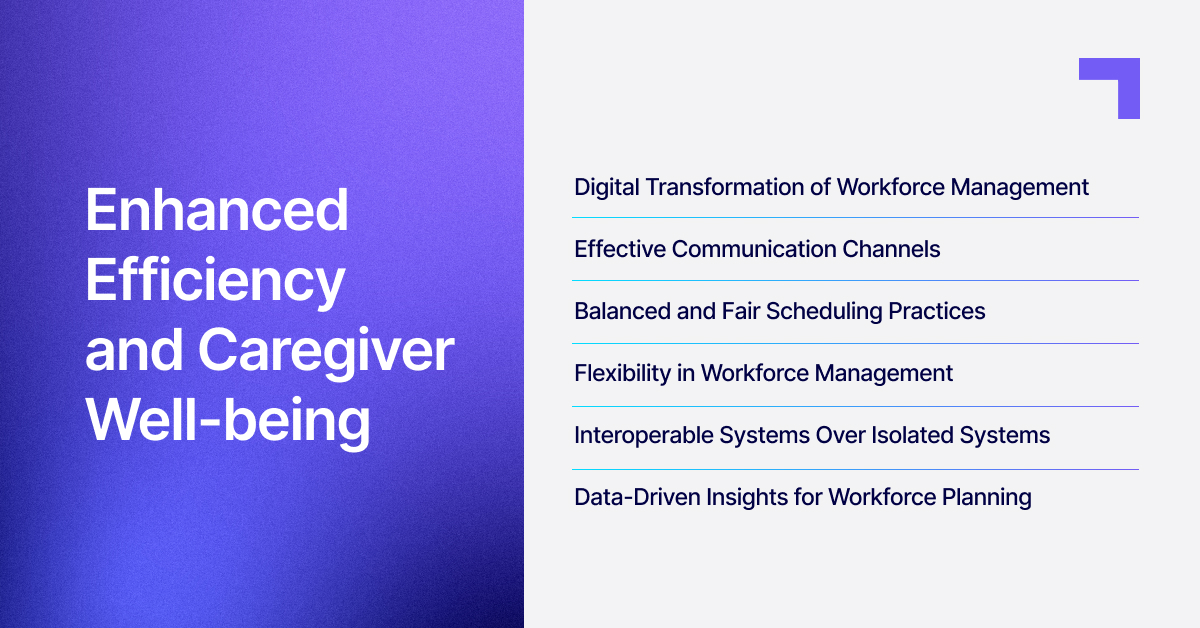
The landscape of healthcare workforce management is at a pivotal point of transformation. Healthcare organizations worldwide are facing a critical and growing challenge of staff shortages, a phenomenon causing significant disruptions in service delivery. This crisis is not confined to any single region but is a global issue impacting healthcare systems at various levels. Traditional workforce management systems, still prevalent in many organizations and characterized by paper-based processes and one-way communication, are increasingly inadequate to address the complexities and demands of modern healthcare delivery. Compounding this issue is the rising trend of caregiver burnout and the concerning number of healthcare professionals considering leaving their profession. These factors collectively highlight the urgent need for a paradigm shift in how healthcare staff scheduling is approached and managed.
Inadequate Workforce Management Tools, Communication Challenges, and Lack of Insight for Workforce Planning
The source of the problem lies in the fact that many healthcare organizations struggle with outdated, paper-based workforce management systems, particularly for physicians and nurses. These inefficient methods burden caregivers with administrative tasks, detracting from patient care. Traditional approaches often prioritize management needs, neglecting the unique requirements of clinicians. In addition, conventional communication tools like pagers, prevalent in healthcare settings, are limited to one-way communication. This unidirectional communication can lead to unnecessary delays, communication gaps and potential errors. Then, healthcare organizations often lack the comprehensive insights necessary for effective workforce planning, including crucial data for balanced workforce distribution and preventing service disruptions.
Staff Shortages, Emergency Department Closures, and High Turnover Rates
The consequences are disastrous. The healthcare sector is experiencing a critical shortage of healthcare providers. For instance, emergency departments closed 158 times in some areas in 2022, equating to 84 days (about 3 months) of lost urgent care (Source: Toronto Star). This phenomenon is not isolated to one health authority but is a global issue, severely impacting patient care delivery.
Many healthcare professionals are contemplating leaving their professions. In some provinces, 60% of RPNs have considered leaving their profession (Source: The State of Nursing in Ontario: A 2023 Report). Furthermore, the percentage of nurses working in the profession decreased from 91.2% in 2016 to 88.9% in 2023, indicating a trend of professionals leaving the field (Source: College of Nurses in Ontario, 2023). Compounding this issue is that staff are leaving the profession faster than new graduates can enter the job market. This reflects a concerning direction for the healthcare sector and underscores the urgency of addressing these turnover rates to maintain effective healthcare delivery.

Evolving Healthcare Workforce Management for Enhanced Efficiency and Caregiver Well-being
Fortunately, the solution is possible, realistic, and feasible in the short term. Addressing the challenges in healthcare workforce management requires a holistic and integrated approach that combines digital solutions with strategic initiatives. This strategy emphasizes real-time communication, balanced and adaptable scheduling, flexibility, interoperable systems, and data-driven insights, creating an efficient and responsive ecosystem that can respond to the needs of patients, care facilities and healthcare professionals.
Digital Transformation of Workforce Management
The shift to digital tools offering real-time updates on schedules and availability is crucial. McKinsey & Company's "Nursing in 2023" report underscores the importance of digital transformation in enhancing the work environment for professional caregivers (Source: McKinsey & Company, 2023). Integral to this transformation is implementing systems that offer complete visibility into the entire healthcare workforce, including physicians, nurses, and other support staff. This comprehensive approach to managing workforce capacity is crucial for efficiently allocating resources and enhancing patient care by ensuring optimal utilization of all healthcare personnel.
Effective Communication Channels
Moving from one-way to more efficient two-way communication tools can significantly improve operational efficiency and reduce errors, facilitating clearer and quicker communication in healthcare settings.
Balanced and Fair Scheduling Practices
Adapting scheduling practices to individual provider and staff needs is essential for work-life balance. The Journal of Nursing Management (2022) discusses the role of technology in facilitating balanced schedules by providing autonomy, thereby improving staff satisfaction and retention.
Flexibility in Workforce Management
Flexibility in scheduling and work arrangements is crucial for enhancing staff engagement and retention, as highlighted by McKinsey's insights on the importance of flexibility in healthcare (McKinsey & Company, 2023). Dynamic scheduling is essential and offers significant benefits for physicians and nurses. For physicians, it allows the flexibility to trade call shifts in response to unexpected events, ensuring shifts remain covered without disrupting patient care. On the other hand, nurses can take advantage of dynamic scheduling to pick up open shifts, aiding their organizations in maintaining appropriate staffing levels. This approach not only meets the immediate needs of healthcare professionals but also supports the operational efficiency of healthcare organizations.
Interoperable Systems Over Isolated Systems
Implementing interoperable systems that integrate various aspects of workforce management across departments is vital for unified operations. Health Affairs (2021) emphasizes the benefits of interoperability in healthcare systems, highlighting its role in ensuring consistency and better resource allocation.
Data-Driven Insights for Workforce Planning
Data analytics for predictive workforce planning based on forecasted demand is critical for optimal staff utilization. The Healthcare Financial Management Association (2022) highlights the significance of data-driven workforce planning in healthcare, enhancing patient care and reducing operational costs.
Benefits of a Dynamic and Agile Workforce Management Approach
Implementing a dynamic and agile approach to workforce management in healthcare brings substantial benefits, crucial for the sector's changing landscape. Key outcomes of this approach include enhanced staff satisfaction, better staff utilization, and improved workforce planning.
A significant benefit is the improvement in work/life balance, leading to increased staff satisfaction. When healthcare professionals achieve a healthier balance between their work and personal lives, it results in higher engagement and retention rates. This is not only beneficial for the staff but also positively influences patient care quality, as content and engaged staff tend to deliver superior healthcare services.
Moreover, this modern approach to workforce management ensures more efficient staff utilization. Utilizing predictive analytics for workforce planning allows healthcare organizations to allocate their resources more effectively. This method ensures that staff with the right skills are available when needed, enhancing patient care and reducing the need for external staffing agencies and overtime for staff, thus contributing to cost efficiency.
Enhanced workforce planning is another crucial outcome. Improved monitoring and analysis of communication and scheduling enable more informed decision-making in workforce management. This level of insight is vital for healthcare organizations to meet future demands effectively. With better planning and an understanding of staffing requirements, healthcare facilities can swiftly adapt to changing needs, ensuring uninterrupted and efficient patient care.
In essence, adopting a more sophisticated workforce management system in healthcare is an essential step in meeting the current and future demands of healthcare providers and patients alike. Recognizing this, Petal is leading the shift towards mobile-first tools that empower caregivers. By focusing on intuitive, mobile–friendly solutions, Petal ensures healthcare professionals can dedicate time to patient care at the right time.
A Dynamic Workforce Capacity Management in Action
Hawkesbury General Hospital (HGH) in Ontario, a medium-sized facility serving nearly 50,000 patients annually, has significantly expanded since 2015. With a $200M investment, it added new spaces for various medical services, increasing its bed count from 69 to 100. This transformation has elevated HGH to a full-service regional hospital, offering high-quality, patient-centered care. In 2019, the hospital was awarded Accredited with Exemplary Standing, the highest accreditation status for a Canadian hospital. Recognizing the need for digital transformation in healthcare, HGH leadership, including former Chief of Staff Dr. Julie Maranda, adopted Petal's capacity management solution in 2018. This web-based solution centralizes on-call lists, streamlines schedule management, and enables real-time updates, significantly reducing the administrative burden.
The implementation of Petal's solution at HGH has revolutionized how schedules are managed, facilitating collaboration between administrators and physicians. This system allows doctors to manage their schedules, request leave, and swap shifts using a web or mobile app without administrative intermediaries. It has led to equitable distribution of shifts and improved work/life balance for the medical staff. The platform was crucial during emergencies, such as a 2019 incident where Dr. Maranda mobilized 20 doctors within minutes using the app. Petal's system also supports the hospital's culture of well-being, enabling staff to have input into their schedules and preventing burnout. With Petal, HGH is well-equipped for future challenges in healthcare, enhancing its appeal to physicians and supporting a seamless continuum of care.
Conclusion
At Petal, we understand that the modernization of workforce capacity management in healthcare is more than a necessity; it's a vital imperative. Our commitment to digital transformation goes beyond merely providing tools; it's about embedding provider-centric solutions that seamlessly integrate with and complement existing healthcare systems. We tackle staff shortages, operational inefficiencies, and communication gaps head-on, ensuring the delivery of high-quality patient care remains uninterrupted.
Our focus on interoperability is crucial. By aligning our solutions with existing healthcare infrastructures, like EHR and HRIS systems, we enhance operational effectiveness and efficiency without the need for overhauling current practices. This thoughtful integration underscores our dedication to improving healthcare operations while respecting the established workflows of our partners.
Moreover, the quality of service at Petal extends beyond our products. We pride ourselves on fostering long-term partnerships and providing expert consultancy, positioning ourselves not just as a solution provider but as a trusted ally in the healthcare sector's digital evolution. By embracing this comprehensive approach, we at Petal are committed to transforming healthcare delivery into a more integrated, efficient, and human-centric experience.
References
McKinsey & Company. (2023). Nursing in 2023. Retrieved from [https://www.mckinsey.com/industries/healthcare/our-insights/nursing-in-2023]
Journal of Nursing Management. (2022). Innovative Scheduling Practices in Nursing.
Health Affairs. (2021). The Importance of Interoperability in Healthcare Systems. Retrieved from [https://www.healthaffairs.org/content/forefront/brink-digital-health-care-transformation-germany-can-learn-united-states]
Healthcare Financial Management Association. (2022). Data-Driven Workforce Planning in Healthcare. Retrieved from [https://www.hfma.org/finance-and-business-strategy/analytics/unleashing-the-power-of-healthcare-workforce-data/]
Toronto Star. (2023). [Staggering' number of Ontario emergency department closures revealed by Star analysis]. Retrieved from [https://www.thestar.com/news/canada/staggering-number-of-ontario-emergency-department-closures-revealed-by-star-analysis/article_6d958c6f-033f-5195-9a6a-4398457f1097.html]

